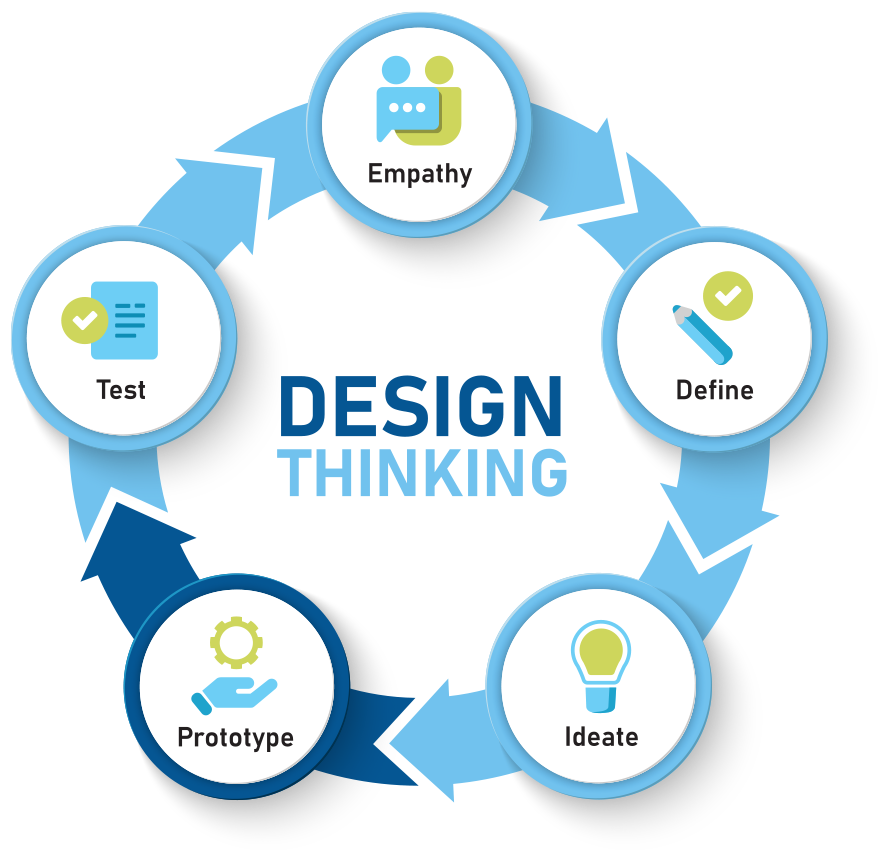PROTOTYPE: The Bridge Between Imagination and Reality in Design Thinking
Posted on March 27, 2024
By Nick Chiechi, President, CS Designworks

In the transformative journey of design thinking, the Prototype phase stands as a critical bridge between conceptual ideas and tangible solutions. Following the stages of Empathy, Define, and Ideate, prototyping is where the rubber meets the road, allowing innovators to explore the feasibility of their ideas and refine them into actionable solutions. This phase is not just about building; it's about learning, iterating, and evolving ideas into something that can truly meet the users' needs.
 The Phases of Design Thinking
The Phases of Design Thinking
Empathy: Understanding your Users
Define: Framing the Problem
Ideate: Generating Solutions
Prototype: Bringing Ideas to Life
Test: Refining the Solution
The Essence of Prototyping
Prototyping is the process of creating simplified, experimental models of ideas to test their viability. These prototypes can range from physical products to digital interfaces, service mock-ups, or even role-playing activities. The key is to make ideas tangible, enabling designers to interact with their concepts, gather feedback, and identify potential improvements.
Why Prototype?
Feedback and Validation: Prototyping allows designers to present their ideas to users and stakeholders in a tangible form, facilitating clear and actionable feedback. This feedback is invaluable for validating the assumptions behind a design and understanding its appeal and usability from the user's perspective.
Fail Fast, Learn Fast: By creating prototypes, teams can quickly identify flaws or areas for improvement, allowing them to fail early in the process when the cost of changes is minimal. This approach fosters a culture of experimentation and learning, where failure is seen as a step towards innovation.
Enhanced Collaboration: Prototyping brings together diverse teams, including designers, engineers, marketers, and users, to collaborate on the development of a solution. This interdisciplinary approach ensures that different perspectives are considered, enriching the design process.
Clarification of Solutions: Complex ideas become clearer when they are embodied in a prototype. This clarity helps teams make more informed decisions, aligning their efforts towards the most promising solutions.
The Prototyping Process
Build: Start by creating a simple version of your idea that focuses on the core functionality or concept you want to test. This doesn't have to be perfect or complete; it just needs to be enough to elicit feedback.
Test: Share your prototype with users and stakeholders, observing their interactions and gathering their feedback. Pay close attention to their behavior, preferences, and the challenges they encounter.
Learn: Analyze the feedback to identify patterns, insights, and areas for improvement. This learning will inform the next iteration of your prototype, helping you refine your idea.
Iterate: Based on what you've learned, make adjustments to your prototype and test again. This cycle of building, testing, learning, and iterating continues until you arrive at a solution that meets the users' needs effectively.
Embracing Prototyping in Your Process
Incorporating prototyping into the design thinking process empowers teams to navigate the complex journey from idea to solution with confidence. It encourages a hands-on approach to problem-solving, where ideas are continuously tested, refined, and validated. Whether you're designing a new product, developing a digital platform, or innovating a service, prototyping is an indispensable tool for turning your vision into reality.
Conclusion
The Prototype phase is a testament to the power of tangible experimentation in the design thinking process. It enables innovators to explore the realm of possibilities, transforming abstract ideas into concrete solutions that can be tested, refined, and ultimately implemented. By embracing the principles of prototyping, teams can ensure that their solutions are not only innovative but also deeply aligned with the needs and desires of their users, paving the way for meaningful and impactful design outcomes.
Prototype in Action: A Hypothetical Example for a Commercial Real Estate Company |
|
As we continue to follow the journey of "UrbanSpace Innovators," a forward-thinking commercial real estate company, we delve into the Prototype phase of the design thinking process. Having navigated through the Empathy, Define, and Ideate phases, UrbanSpace Innovators is now poised to bring their innovative ideas to life through prototyping. Recap of Ideate Phase InsightsIn the Ideate phase, UrbanSpace Innovators generated a wealth of creative solutions aimed at transforming their office spaces to be more flexible, personalized, and community-focused. Ideas ranged from modular office layouts and community hubs to digital collaboration platforms and flexible lease terms. |
|
Transition to Prototype Phase Activities in the Prototype Phase Testing and Gathering Feedback Iterative Refinement Impact of the Prototype Phase Wrapping It All UpThe Prototype phase is a critical step in the design thinking process, bridging the gap between abstract ideas and practical solutions. For UrbanSpace Innovators, this phase was instrumental in refining their innovative concepts into actionable plans, moving them closer to redefining the commercial real estate landscape. By embracing prototyping, they were able to experiment, learn, and iterate, ensuring that their final offerings would not only meet but exceed the expectations of their tenants. This example highlights the power of prototyping in turning ideas into reality, paving the way for meaningful innovation in any sector. |
Next Up: Phase 5 – Test
Previous: Phase 3 – Define
Read our Design Thinking Overview
Join Our Blog Community
@CSDesignworks


